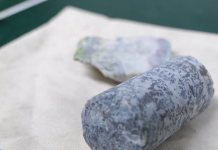BEIJING: At 11:23 a.m. on April 29, a rocket blasted off from the Wenchang Spacecraft Launch Site in Hainan Province, carrying the core section of China’s space station.
After traveling a little over eight minutes on the domestically developed Long March-5B Y2 rocket, the module, named Tianhe, which means harmony of the heavens, separated from the rocket and entered into orbit. A key step in the construction of the space station that is expected to be completed next year, Tianhe will act as the management and control hub of the station as well as a node for docking with other spacecraft, up to three at a time, including both manned and cargo spacecraft.
The successful launch marks China’s space station construction entering the full implementation stage, laying a solid foundation for follow-up tasks, President Xi Jinping said in a congratulatory message.
The space station, Tiangong or heavenly palace, will be a crewed space station independently built with homegrown technologies. Besides Tianhe, it will have two other sections, Wentian and Mengtian. Expected to be launched next year, these are the space laboratories for conducting experiments in a wide range of areas including space medicine, technology and life science.
“Building a space station and national space laboratory is an important goal of the three-step strategy of China’s manned space program, and an important leading project to boost the country’s strength in science and technology, as well as in space,” Xi said.
When China’s manned space program started in 1992, the first step was to send astronauts into space and have them return safely. Shenzhou-1, the country’s first experimental manned spacecraft, was launched with no crew in 1999 and four years later, Shenzhou-5 successfully sent Yang Liwei, China’s first astronaut into space. Yang, a military pilot, was 38 at that time.
The milestone feat made China the third country to send astronauts into space.
The second stage was to test key technologies needed for a permanent space station, including extra-vehicular activities and orbital docking.
In 2008, fighter pilot Zhai Zhigang ventured out of the Earth-orbiting Shenzhou-7 spacecraft and walked in space, becoming China’s first taikonaut to leave a “footprint in the universe.”
To amass more experience for developing a space station, an experimental space lab, Tiangong-1, was lifted up in 2011 to test the technologies for rendezvous and docking between spacecraft. A month later, Shenzhou-8 entered into orbit and accomplished the first automatic rendezvous and docking with Tiangong-1.
In 2016, an improved version, Tiangong-2 was launched. It docked with Tianzhou-1, China’s first cargo spacecraft, in April 2017, which also carried out the first in-orbit refueling.
So far, China has launched 11 manned spacecraft, one cargo spacecraft, and Tiangong-1 and Tiangong-2 into space, as well as sent 11 astronauts, and completed the first two steps of its manned space program.
– The Daily Mail-Beijing Review News exchange item





